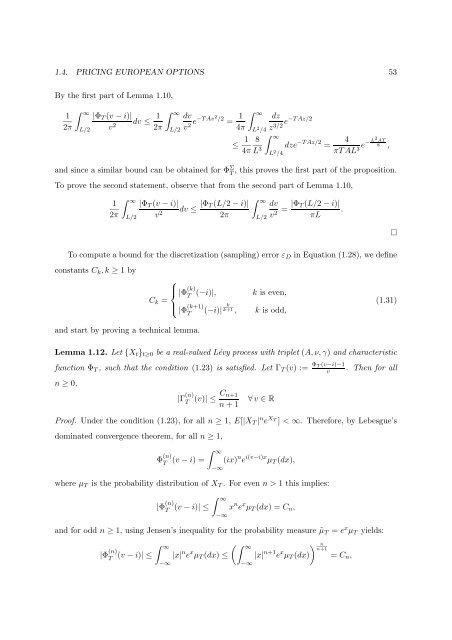Processus de Lévy en Finance - Laboratoire de Probabilités et ...
Processus de Lévy en Finance - Laboratoire de Probabilités et ...
Processus de Lévy en Finance - Laboratoire de Probabilités et ...
Create successful ePaper yourself
Turn your PDF publications into a flip-book with our unique Google optimized e-Paper software.
1.4. PRICING EUROPEAN OPTIONS 53<br />
By the first part of Lemma 1.10,<br />
∫<br />
1 ∞<br />
|Φ T (v − i)|<br />
2π L/2 v 2 dv ≤ 1 ∫ ∞<br />
dv<br />
2π L/2 v 2 e−T Av2 /2 = 1 ∫ ∞<br />
4π L 2 /4<br />
≤ 1<br />
4π<br />
dz Az/2<br />
e−T<br />
z3/2 ∫<br />
8 ∞<br />
L 3 dze −T Az/2 =<br />
L 2 /4<br />
4<br />
πT AL 3 e− L2 AT<br />
8 ,<br />
and since a similar bound can be obtained for Φ Σ T<br />
, this proves the first part of the proposition.<br />
To prove the second statem<strong>en</strong>t, observe that from the second part of Lemma 1.10,<br />
∫<br />
1 ∞<br />
2π L/2<br />
|Φ T (v − i)|<br />
v 2 dv ≤ |Φ ∫<br />
T (L/2 − i)| ∞<br />
dv<br />
2π L/2<br />
v 2 = |Φ T (L/2 − i)|<br />
.<br />
πL<br />
To compute a bound for the discr<strong>et</strong>ization (sampling) error ε D in Equation (1.28), we <strong>de</strong>fine<br />
constants C k , k ≥ 1 by<br />
⎧<br />
⎪⎨<br />
C k =<br />
⎪⎩<br />
|Φ (k)<br />
T<br />
(−i)|, k is ev<strong>en</strong>,<br />
|Φ (k+1)<br />
T<br />
(−i)| k<br />
k+1 , k is odd,<br />
(1.31)<br />
and start by proving a technical lemma.<br />
Lemma 1.12. L<strong>et</strong> {X t } t≥0 be a real-valued Lévy process with tripl<strong>et</strong> (A, ν, γ) and characteristic<br />
function Φ T , such that the condition (1.23) is satisfied. L<strong>et</strong> Γ T (v) := Φ T (v−i)−1<br />
v<br />
. Th<strong>en</strong> for all<br />
n ≥ 0,<br />
|Γ (n)<br />
T (v)| ≤ C n+1<br />
n + 1<br />
∀ v ∈ R<br />
Proof. Un<strong>de</strong>r the condition (1.23), for all n ≥ 1, E[|X T | n e X T<br />
] < ∞. Therefore, by Lebesgue’s<br />
dominated converg<strong>en</strong>ce theorem, for all n ≥ 1,<br />
Φ (n)<br />
T<br />
∫ ∞<br />
(v − i) = (ix) n e i(v−i)x µ T (dx),<br />
where µ T is the probability distribution of X T . For ev<strong>en</strong> n > 1 this implies:<br />
−∞<br />
∫ ∞<br />
|Φ (n)<br />
T<br />
(v − i)| ≤ x n e x µ T (dx) = C n ,<br />
−∞<br />
and for odd n ≥ 1, using J<strong>en</strong>s<strong>en</strong>’s inequality for the probability measure ˜µ T = e x µ T yields:<br />
∫ ∞<br />
(∫ ∞<br />
) n<br />
|Φ (n)<br />
T<br />
(v − i)| ≤ |x| n e x µ T (dx) ≤ |x| n+1 e x n+1<br />
µ T (dx) = Cn ,<br />
−∞<br />
−∞
















